
* The Mi-8 series has been produced in a wide number of variants, running through three generations, with development continuing in the 21st century. This chapter outlines the evolution of the Mi-8 series.
* The experimental design bureau (OKB in its Russian acronym) under Mikhail Lyeontivich Mil was responsible for several early Soviet helicopters, including the piston-powered "Mi-1 Hare" and larger "Mi-4 Hound", leading to the turboshaft-powered heavy-lift "Mi-6 Hook". In 1957, the Mil OKB began to consider a successor to the medium-lift Mi-4, powered by twin turboshaft engines. At the time, there was for various reasons a bias against the development of new aircraft types, and so the new machine was sold as an "upgrade" of the Mi-4 -- which was something of a stretch, it was basically a new design, but it did leverage off Mi-4 assemblies such as the tailboom, rotor system, and landing gear.
In February 1958, the Soviet Council of Ministers guardedly approved the plan. The ministers authorized development of a medium-lift helicopter, with the OKB designation of "V-8" -- where "V" stood for "vertolyot (helicopter)" -- to be powered by a single Ivchenko Al-24V turboshaft engine, providing 1,420 kW (1,900 SHP). The Al-24V was a derated turboshaft version of the 1,790 kW (2,400 SHP) Al-24 turboprop then in development for the Antonov An-24 twin-engine transport aircraft.
Mil OKB engineers were not at all happy with the requirement to use a single engine since it compromised safety, and also did not like the fact that the Al-24V was a fuel hog. Mikhail Mil lobbied the authorities to approve parallel development of a twin-engine version, pointing out that the machine would be used as a VIP transport, and that it would be unwise to compromise the safety of Soviet leadership. The appeal to self-interest proved successful; after preliminary designs and a full-scale mockup were inspected, approval for the twin-engine "V-8A" was given in May 1960. There were the problems that no appropriate turboshaft engine actually existed to power the V-8A and that twin engines would require a new main gearbox to mesh their output power, but the Isotov engine OKB came on board to design a new turboshaft, the TV2, with a power rating of 930 kW (1,250 SHP), and also to implement the two-into-one gearbox.
The single-engine V-8 was the first to fly, performing its initial flight on 24 June 1961, with test pilot Boris V. Zemskov. This machine had the rotor system and other elements taken direct from the Mi-4 -- the engineers actually wanted to improve on Mi-4 based components, but that would take a bit of time, and Mil needed to get the machine flying quickly. It was configured as a passenger liner, with 18 seats and rectangular windows, and also had mainwheel spats, which would not be featured in production machines.
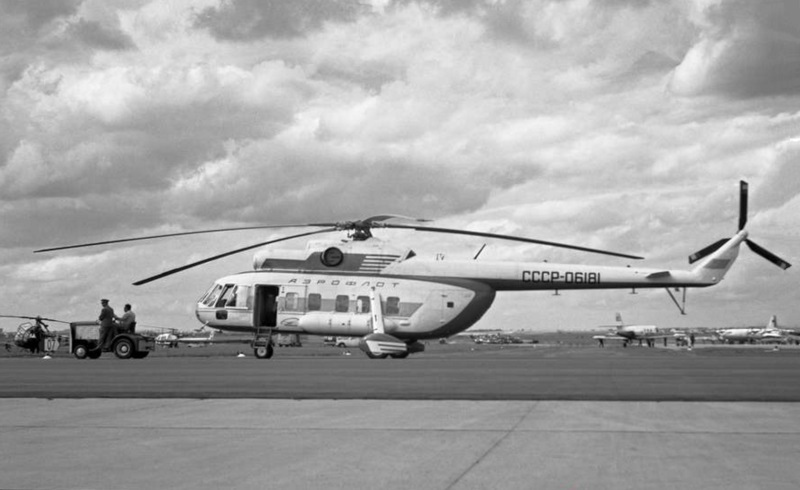
The V-8 was displayed to the world on 9 July 1961 at the Moscow Tushino Airport airshow, with NATO assigning the type the reporting name "Hip", to become "Hip-A" after other versions appeared. By the time the V-8 took to the air, whatever interest there had been in putting it into production had generally faded out, and it was simply used as a test rig, finally being grounded in 1963, to be later scrapped. Two other V-8 prototypes were built but they never flew, being used as ground-test airframes.
Initial full flight of the first prototype of the twin-engine V-8A was on 17 September 1961, with test pilot V.N. Loshkin at the controls. As it initially flew, it was very similar to the V-8 -- 18-seat heli-liner configuration with mainwheel spats and four-bladed rotor -- except for twin TV2 turboshafts. It was gradually fitted with new kit as it became available, particularly a five-bladed rotor leveraged from the Mi-4 four-bladed rotor, bringing the machine closer to production spec. When NATO became aware of the V-8A, it was assigned the reporting name "Hip-B". This prototype served faithfully as a development platform until it crashed in January 1966, killing all three crew on board.
Two more initial V-8A series flight prototypes were built, including the "V-8AT" military assault transport prototype, and the "V-8AP" VIP transport. The V-8AT performed its initial flight in the summer of 1963; although it had a military configuration and good military green paintjob, it retained rectangular windows of the heli-liner configuration. It was temporarily modified the next spring, 1964, to a VIP transport configuration to act as a demonstrator for the V-8AP, which performed its own initial flight in the spring of 1964. It was later modified to a heli-liner configuration.
The trials went very well, with the V-8A prototypes demonstrating that they had twice the lift capability and 50% more speed than the Mi-4, and were much more economical to operate. The military version, which was also intended for civil use, was ordered into production as the "Mi-8T" in the fall of 1964, with the heli-liner version authorized as the "Mi-8P" in the spring of 1965. Both were assigned the NATO reporting name of "Hip-C". Initially, production was assigned to State Factory 387 in Kazan, now capital of the Republic of Tatarstan. Factory 387 was already building the Mi-4 and the first Mi-8s began rolling off the production line in late 1965. In 1970, with demand for the Mi-8 running high, State Factory 99 at Ulan-Ude in Siberia also would begin production of the type.
The "Hip" was in fact an outstanding machine, an example of Soviet engineering at its best: sturdy, reliable, easy to maintain and operate, capable, and relatively inexpensive. It would prove to be one of the most significant helicopters ever built.
BACK_TO_TOP* Although the Mi-8 family would undergo considerable evolution during its lifetime, the Mi-8T provides a useful baseline for the type.
The Mi-8T was built mostly of aircraft aluminum, with a bus-like body slung under an engine assembly consisting of twin Isotov TV2-117A turboshafts, trailed by a tail boom. Each engine provided 1,120 kW (1,500 SHP) max, but the rotor system couldn't tolerate the full power of both engines, and so there was a limiter system to restrict engine output power; however, if one engine went down, the other could then operate at full rated power. The engine inlets featured a de-icing system using hot engine bleed air.
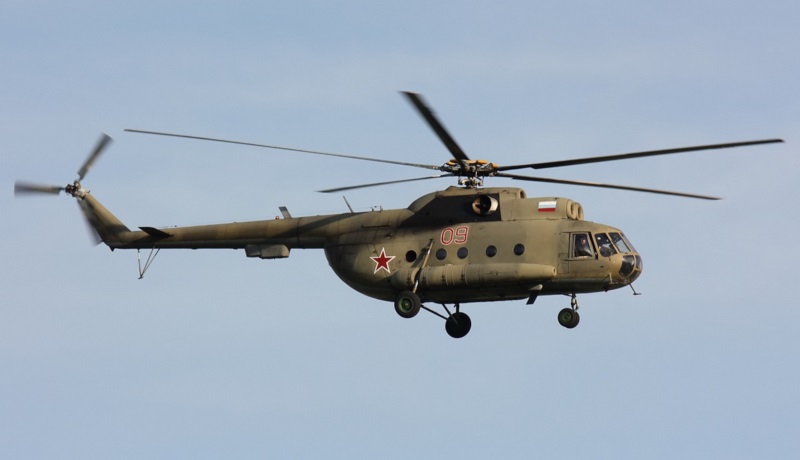
Later production had uprated TV2-117F engines with 1,268 kW (1,700 SHP) each, to be followed in turn by TV2-117AG engines with the same ratings but lower cost and greater reliability, partly thanks to graphite seals. It is very difficult to determine exactly which variants of the Mi-8 were fitted with which TV2 engine variant, all the more so because it's very possible some early machines were upgraded to improved engines over their service lives.
The engine service doors hinged down and were sturdy enough to be used as work platforms when open, a common gimmick among Mil helicopters. There was an access hatch in the roof of the cargo bay to allow service personnel to climb on top of the helicopter.
The main rotor system had five blades, while the tail rotor had three, with the tail rotor mounted to the right. All the rotor blades were made of metal and featured an electrothermal de-icing system. A tailplane was fitted forward of the tail rotor, and most (though not all) Mi-8T production had a boxy fairing underneath the tailboom for a Doppler speed sensor. The tailboom could be detached with relative ease for transport or storage.
Tricycle landing gear was fitted, with the castoring nose gear featuring two wheels and each main gear assembly featuring one wheel; the main gear was mounted on shock-absorbing tripod frames. Steering while taxiing was by differential braking. The mainwheel spats fitted to prototypes were deleted in production machines. Fuel storage was in external fuel tanks, one on each side of the fuselage forward of the main landing gear; initially, fuel capacity was 745 liters (196 US gallons) for the left-side tank and 680 liters (179 US gallons) for the right-side tank, but late production featured enlarged tanks with 1,140 liters (301 US gallons) and 1,030 liters (272 US gallons) respectively. The right-side external tank had an extended fairing on its nose to accommodate a cabin heater. There was also a reserve tank with a capacity of 445 liters (117 US gallons) mounted behind the main gearbox, and twin ferry tanks with a capacity of 915 liters (241 US gallons) could be temporarily fitted in the cabin.
The pilot and copilot sat side-by-side in the nose, with a jump seat for a flight engineer behind them; the cockpit was separated from the cargo bay by a bulkhead with a door. Although consideration had been given in the design phase to a "stepped" nose like that of the big Mi-6, as developed the Mi-8 had a glassed-in front that gave it a "snubbed nose" appearance. The three main windshield panels were made of glass -- the others were Perspex -- and were electrically de-iced, with the pilot's and copilot's panels also featuring a windshield wiper. The (sliding) cockpit side windows were bulged to give the aircrew a better view back and down. There had been an additional small lower window under the side windows in the prototypes, but it was deleted in production.
There was a sliding entry door with fold-down steps behind the cockpit on the left, with provision for mounting a rescue hoist above the door. The standard configuration included 24 tip-up seats alongside the cargo bay walls for troop transport, though this configuration could be changed to a medical evacuation ("medevac") configuration with 12 stretchers and one tilt-down seat for a medical attendant. There were circular portholes along each side of the fuselage that could be tilted in and up to be locked in open position, allowing troops to fire their weapons from mounts fitted to the porthole frames.
Clamshell doors were fitted at the rear for freight loading, with an escape hatch in one door. Twin hook-on ramps were carried to allow vehicles to drive in; an integral ramp had been featured in prototype development, but the integral ramp wasn't always a benefit: when loading from the back of a truck, it was easier to get rid of the ramps and just back the truck up to the rear of the helicopter.
The cargo bay had a length of 5.34 meters (17 feet six inches), a width of 2.3 meters (7 feet 6 inches), and a height of 1.82 meters (6 feet). There were cargo tie-downs on the floor and an electric hoist system in the ceiling with load capacity of 200 kilograms (440 pounds). Maximum internal cargo capacity was 4,000 kilograms (8,800 pounds), with loads including light vehicles, artillery pieces, and the like. Twin ferry tanks could be installed in the cargo bay. There was an external sling system underneath the helicopter with a capacity of 3,000 kilograms (6,600 pounds) for carrying loads too bulky to fit in the cargo bay.
___________________________________________________________________
MIL MI-8T "HIP-C":
___________________________________________________________________
main rotor diameter:
21.29 meters (69 feet 10 inches)
tail rotor diameter:
3.8 meters (12 feet 6 inches)
fuselage length:
18.31 meters (60 feet)
footprint length:
25.35 meters (83 feet)
height (tail rotor):
5.54 meters (18 feet 2 inches)
height (rotor head):
4.76 meters (15 feet 7 inches)
empty weight:
7,160 kilograms (15,785 pounds)
max loaded weight:
12,000 kilograms (26,455 pounds)
maximum speed (performance specs at normal loaded weight):
250 KPH (155 MPH / 135 KT)
service ceiling:
4,500 meters (14,760 feet)
range:
425 kilometers (265 MI / 230 NMI)
___________________________________________________________________
* The Mi-8T was designed from the outset to carry armament, though the machine wasn't actually available in armed form until 1968. It could be fitted with the weapons outrigger system from the Mi-4AV, with twin stores racks on each outrigger, typically carrying a total of four 16-round 57-millimeter unguided rocket pods, targeted by a sight fitted in the cockpit. Bombs of up to 500 kilograms (1,100 pounds) each could also be carried, though bombs seem to have been an unusual store. The lower forward cockpit window could be replaced with a panel featuring a swivel mount for a 7.62-millimeter Kalashnikov PKT machine gun. The armed version was eventually referred to as the "Mi-8TV" -- where the "V" stood for "voruzhonniy (armed)" -- but it wasn't at all different from any other Mi-8T except for the weapons kit, and any Mi-8T could be easily equipped with the same armament configuration. NATO still gave it the "Hip-C" reporting name.
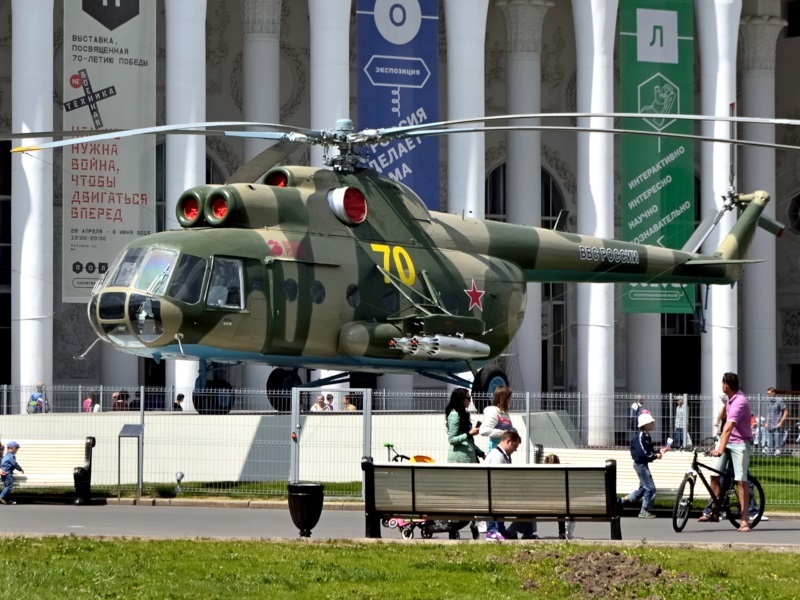
In 1974, the Kazan plant decided to "up-arm" the Mi-8TV. The "Mi-8TV-2" -- an informal designation, the improved machine was still an Mi-8TV -- featured a new armament system with three stores racks on each outrigger, capable of carrying heavier loads, generally a 32-round 57-millimeter rocket pod, providing a total of six pods and 192 rockets. A total of four 9M17P Falanga-P (NATO AT-2 Swatter-C) anti-tank rockets could be mounted on top of the outriggers as well, with the helicopter fitted with a radio link to control the missiles and the copilot directing them with a gyrostabilized sight.
The nose-mounted machine gun was retained. The fuel tanks were filled with polyurethane foam to improve combat survivability. A similar "Mi-8TVK" was built for export, differing only in replacing the four Falanga-Ps with six wire-guided 9M914M Malyutka (NATO AT-3 Sagger) antitank missiles. NATO gave the up-armed Mi-8TV the reporting name "Hip-E", with the export model being labeled the "Hip-F". It appears that Soviet practice was to use them generally as dedicated gunships, since when they had a full load of munitions they couldn't carry much else.
Late-production military Hip variants were sometimes fitted with chaff-flare dispensers, along with an "infrared countermeasures (IRCM)" beacon on the back behind the rotor system, to provide defense against heat-seeking missiles. As with engine fits, it is unclear which variants had countermeasures, and if they were refitted to older machines later.
BACK_TO_TOP* The Mil-8T was used as the basis for a set of tactical airborne command posts for battlefield operations, beginning with the "Mi-8VKP" AKA "Mi-8VZPU" -- the suffixes corresponded to different Russian phrasings of the term "airborne command post". All were refits of stock Mi-8Ts. They featured a nonstandard antenna fit to support command and control communications, most significantly twin outward-canted "towel rack" antennas above the end of the fuselage, as well as rectangular equipment boxes permanently fitted to the external stores outriggers. It received the NATO reporting name of "Hip-D".
The "Mi-8IV" AKA "Mi-9" was a purpose-built tactical airborne command post, using an airframe that had porthole windows like the Mi-8T but the clamshell door arrangement of the Mi-8P heli-liners. It didn't have the external equipment boxes, but it did have a nonstandard antenna arrangement, most significantly long strake antennas under the fuselage. It went into production in the late 1970s, and received the NATO reporting name of "Hip-G".
* There was also a series of electronic countermeasures (ECM) "Hips", intended for the battlefield jamming mission. One of the first was the "Mi-8MV", which carried the "Smalt'a-V" ECM system to jam battlefield air-defense radars. It was a relatively discreet modification of the Mi-8T, the main distinguishing feature being loss of a forward window on each side to permit fit of a dielectric panel for ECM gear; a similar dielectric panel on each side of the fuselage forward of the rear clamshell doors; and a short wire antenna strung on two short stubs and running down the belly. It was given the NATO reporting name of "Hip-J". Mi-8MVs were often upgraded in service with improved ECM packages, to sport a slightly altered set of antennas.
The "Mi-8PP" was developed more or less in parallel. It also was designed to jam air-defense radars, but it had a signals intelligence (SIGINT) function as well. It featured a "Pole (Field)" ECM system and was much more cluttered in appearance than the Mi-8MV, with each side of the machine featuring a box on the middle fuselage and a rectangular array of six X-shaped antennas in a two-rows-of-three arrangement on the rear fuselage. Since the ECM gear generated a lot of heat, there were six heat exchangers in fairings in a row underneath the fuselage. The Mi-8PP was given the NATO reporting name of "Hip-K".
An improved version, the "Mi-8PPA", featured the improved "Akatsiya (Acacia)" ECM suite. It looked almost exactly like the Mi-8PP and was also referred to as the "Hip-K" by NATO.
* There was a very wide range of military Mi-8 subvariants that were only made in small numbers:
There were a number of one-off modifications as well. One Mi-8T was modified to set a world speed record for its class of 273 KPH (170 MPH) on 23 August 1967, flying with an all-woman crew. This machine featured spats on the mainwheels and no external fuel tank pods, all fuel storage being moved inside. There was interest in a high-speed "compound helicopter" to be designated the "Mi-8S", with stub wings and auxiliary turbojets, but it didn't happen.
The modifications included a number of trials machines, sometimes referred to with the designation of "Mi-8LL". The "LL" suffix means "Letushchaya Laboratoriya / Flying Laboratory" and was commonly applied to trials machines of all sorts -- though sometimes such machines were assigned specific designations, or no particular new designation. Trials "Hips" were used to evaluate "flying crane" systems; night vision systems; laser target designators; and even to propulsion with liquid hydrogen and liquefied natural gas. Finally, there were conversions to perform geophysical and environmental surveys, and even one set up to perform on-site air accident investigations.
BACK_TO_TOP* As mentioned specific civil heli-liners and the like were built as well. The Mi-8P passenger helicopter variant -- such machines built in Ulan-Ude were designated "Mi-8AP" -- was very similar to the military variant, with the same performance and load limits. The major distinguishing characteristic was rectangular windows instead of portholes; there were also emergency exits on each side of the fuselage at the rearmost window position. Clamshell doors were retained, though they were smaller, and there was a passenger door nested into them. Standard seating was 28 seats, though 26-, 24-, and 20-seat layouts were eventually adopted as well. The seats could be yanked to permit cargo carriage, and of course sling loads could be carried even if the seats were retained.
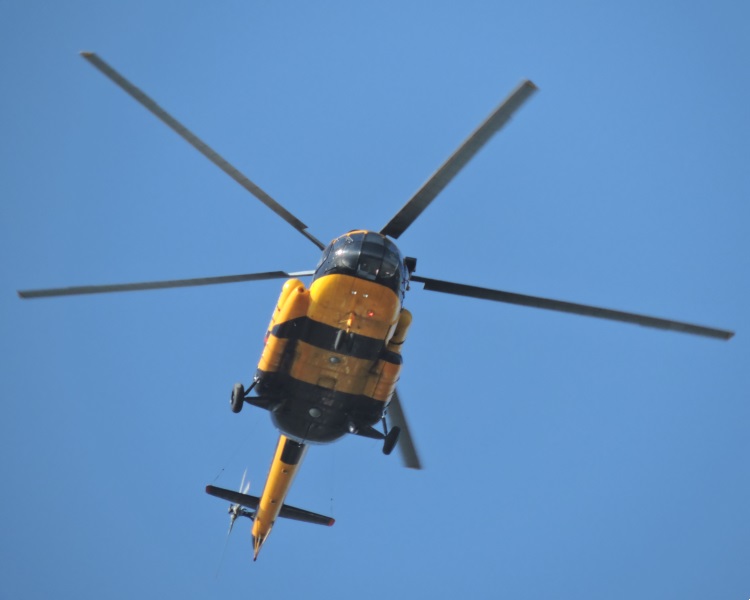
The Mi-8P was the basis for the "Mi-8PS" VIP transport variant, with the "S" standing for "Salon" -- Ulan-Ude machines were designated "Mi-8APS", incidentally. The Mi-8PS was very similar to the M-8P, but which was configured with luxury accommodations for 11, 9, or 7 passengers -- the different configurations sometimes being distinguished by the designations "Mi-8PS-11", "Mi-8PS-9", and "Mi-8PS-7" respectively. The "Mi-8APS" was an Mi-8PS built at Ulan-Ude.
The Mi-8P also led to the "Mi-8S" VIP transport, which visibly differed from the Mi-8P in fit of an air-conditioning system as a forward extension of the left-side fuel tank, matching the heater system extension on the right. This led to replacement of the sliding door (which no longer had any place to slide to) with a fold-down door featuring integral stairs. A secure communications system was added. Interior fit and accommodations were semi-custom, essentially installed at customer request. In reality, the distinction between the Mi-8PS and Mi-8S was never very clear, with some Mi-8PS machines featuring the folding door and air conditioner, while some Mi-8S machines featured the sliding door and did without the air conditioner.
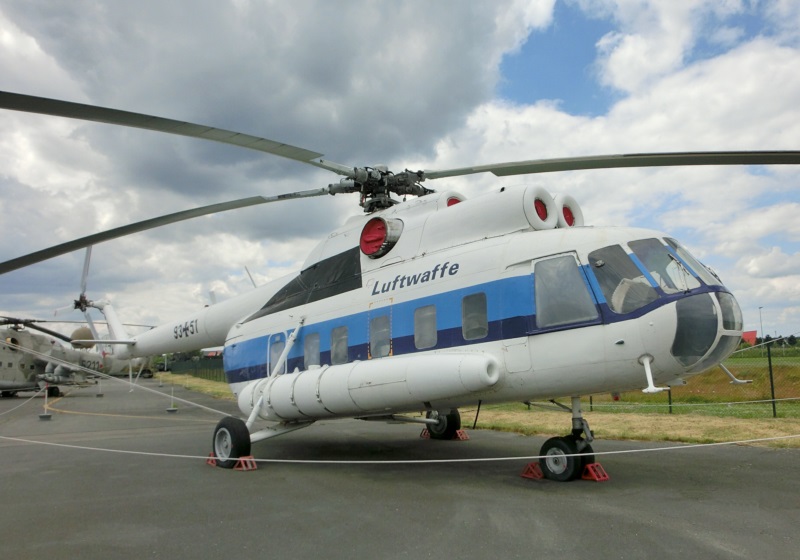
* As hinted earlier, the Mi-8T military version of the Hip was also used in the civil utility role, though this is confusing because in many cases flying machines assigned to Aeroflot, the state airline, were actually used by the military, and were not all that different from military-spec machines. They all had round windows. For what it's worth, the list included:
* The Kazan plant built about 4,500 first-generation "Hips" in all, with about 1,700 exported -- along with about 3,700 built at Ulan-Ude, all for Soviet use. That quantity alone would make the "Hip" significant, but the machine was really only beginning its design life.
From the mid-1960s there was work on an enlarged and improved version of the Mi-8, which was assigned the provisional designation of "Mi-8M", the "M" effectively standing for "modernized". The project bogged down and was canceled in the early 1970s, but it served as the basis for the "Mi-8MT", the starting point of a less ambitious second-generation Mi-8 series -- here informally referred to as "Mi-8 Series II" as compared to first generation "Mi-8 Series I" machines, though these designations were never actually used in service.
The major improvement in the Series II was the fit of more powerful TV3-117MT turboshafts -- developed for the heavier Mi-14 "Haze" and with 1,420 kW (1,900 SHP) each -- along with an uprated rotor transmission system to handle the greater power. The tail rotor was switched from the right side of the tailboom to the left, which improved its effectiveness. An Ivchenko Al-9V auxiliary power unit (APU) was added, being placed at the rear of the engine fairing and making the fairing noticeably larger in the rear, with an exhaust for the APU on the left side. An emergency exit was added in a cabin window on the right side of the fuselage. Although the Mi-8-II otherwise looked much like the first generation "Hip", there were many production changes "under the skin" to reduce weight and improve durability.
As with the original Mi-8T, the Mi-8MT could be equipped with armament. Originally the armament was the same as with the Mi-8TV, consisting of a 7.62-millimeter PKT machine gun in the nose -- the gun position, however, was moved upward -- and outriggers for carriage of rocket pods and anti-tank guided missiles. There was no distinct designation for an armed Mi-8MT.
Since production of Mi-8 Series I machines was well-established, there was some resistance in the bureaucracy to take on the burden of shifting production to a substantially updated version. However, the performance of the Series I under "hot and high" (hot weather, high ground altitude) conditions was marginal, and there was considerable pressure to move to the more powerful second generation.
The Mi-8MT went into production at the Kazan plant in 1977. The new variant was displayed at the Paris air show in 1981, with NATO assigning it the reporting name "Hip-H". Export variants were given the general designation of "Mi-17". Mi-8 Series I models remained in production in parallel for a time, partly because production of TV3-117MT engines was limited, partly because it wasn't possible to replace all the specialized Mi-8-I subvariants on the manufacturing lines right away. Series I "Hips" were finally out of production by 1986.
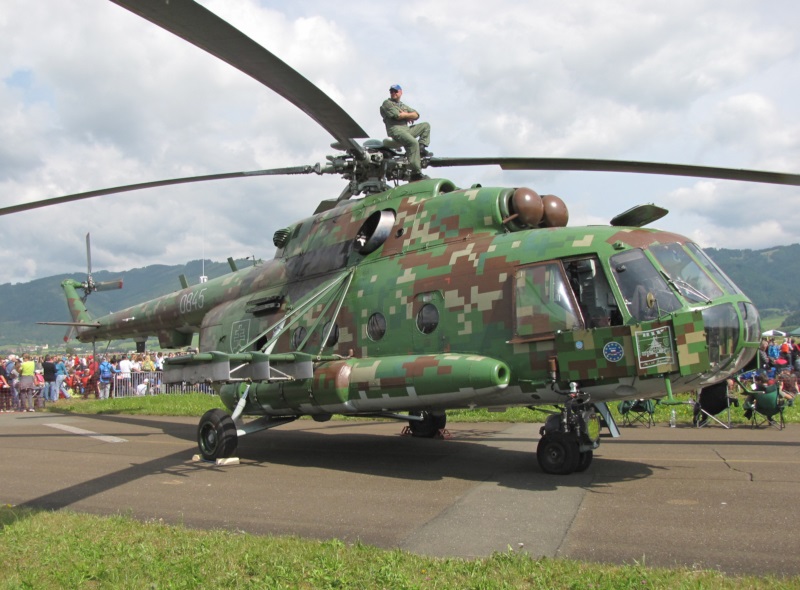
* Combat experience during the Soviet war in Afghanistan through the 1980s demonstrated that much needed to be done to improve the "Hip's" survivability. Given that "hot & high" conditions were normal in the country the Series I machines were clearly inadequate, but the Series II machines also left something to be desired. Necessary improvements were rolled into production on an ongoing basis:
Flotation gear was developed for the Mi-8TV series, with inflatable packs alongside the nose and on the mainwheels, giving the misleading appearance of spats; they seem to be a rare fit, usually associated with civil and SAR variants.
* There was, of course, a wide range of subvariants of the Mi-8-II series. The "Mi-19" was a follow-on to the Mi-9 aerial battlefield command post, with a specialized version, the "Mi-19R", produced for the Soviet Strategic Rocket Force, it seems for mobile missile launch units.
There was a wide range of ECM variants with designations such as "Mi-8MTI", "Mi-8MTP", "Mi-8MTPB", "Mi-8MTPI", "Mi-8MTPSh", "Mi-8MTD", "Mi-8MTS", "Mi-8MTR1" & "Mi-8MTR2", "Mi-8MTU", "Mi-8MTSh1", "Mi-8MTSh2", "Mi-8MTSh3", "Mi-8MTYa", and "Mi-8MT-1S". Export models were designated "Mi-17P", "Mi-17PI", and "Mi-17PG". Many were one-of-a-kind fits; NATO understandably shrugged and designated them all "Hip-K".
A passenger version of the Mi-8TV was sold for export as the "M-17P". It was configured much like an Mi-8P, but had circular windows. There were a number of VIP conversions as well, with a confusing variety of designations; the "Mi-8MS" designation is used here for all of them. Other subvariants included:
Other conversions and modifications of the Mi-8-II included a dozen modified for weather research; a testbed for radar systems; and test or trials machines.
BACK_TO_TOP* In the later 1980s, the Mi-8-II series was fitted with improved TV3-117VM turboshafts -- they had the same power rating as earlier TV3-117MT but, partly thanks to an electro-hydraulic engine control system, could maintain power much better under "hot & high" conditions. Development had been driven by experience in Afghanistan, but work on the improved engine variant was protracted, and it wasn't available until the Soviets were on the way out of the conflict.
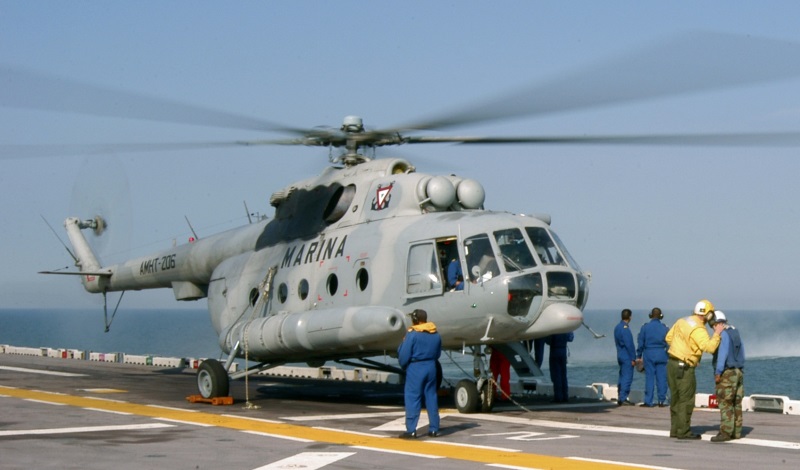
The baseline model of the revised "Hip" series was the "Mi-8MTV", where "V" stood for "vysotniy (high altitude)"; it was sold for export as the "Mi-17V". Other fits to the variant were continuation of and improvement on fixes gradually added in response to combat in Afghanistan, produced as standard: additional armor, foam-filled fuel tanks to reduce explosion hazard, modification of some components and layout to improve survivability, more chaff-flare dispensers, exhausts modified to permit fit of exhaust filters, and the rear mount for a PKT machine gun. There were three main production variations:
One Mi-8MTV-1 was modified into the "Mi-8MTV-K" flying crane, with a distinctive crane operator's cab replacing the rear clamshell doors; this subvariant didn't go into production. There was also an ambulance version, the "Mi-8MTVM".
* After the collapse of the Soviet Union, the Kazan and Ulan-Ude plants continued to build and develop the Mi-8 series, but they did it more or less independently -- becoming "bitter friends" and competitors. The Kazan plant became the "Kazan Helicopters" company, while Ulan-Ude became very simply the "Ulan-Ude Aviation Plant (UUAP)". Both Kazan and UUAP are now part of the "Russian Helicopters" group, the Kamov organization having been thrown in for good measure. While domestic orders were slow, there was still considerable interest from the export market.
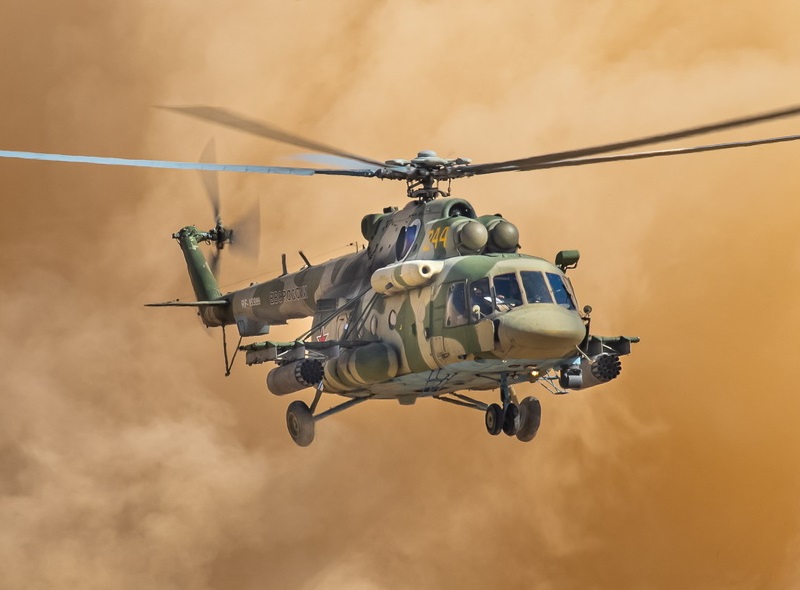
Kazan Helicopters developed a "third generation" series to introduce the "Mi-8MTV-5" in 1996. UUAP went on to their own third generation, starting with the "Mi-8AMT". The new "Hip-3G" machines -- to make up a useful general designation -- offered a variety of features:
Utility versions of Hip-3G could be configured for personnel or cargo transport, including sling loads; other configurations supported medevac, search & rescue, and fire-fighting roles. Accessories included additional fuel tanks, cable cutters, a searchlight, a rescue winch, and so on. Combat versions -- sometimes designated "Sh" for "Shturm (Storm / Assault)" -- could have armor, defensive countermeasures, door guns, and offensive armament on pylons. Offensive armament could include gun and unguided rocket pods, aimed by a cockpit gunsight; or anti-armor weapons such as the radio-guided "Shturm / Ataka" or laser-guided "Vikhr", aimed with a targeting turret / guidance system.
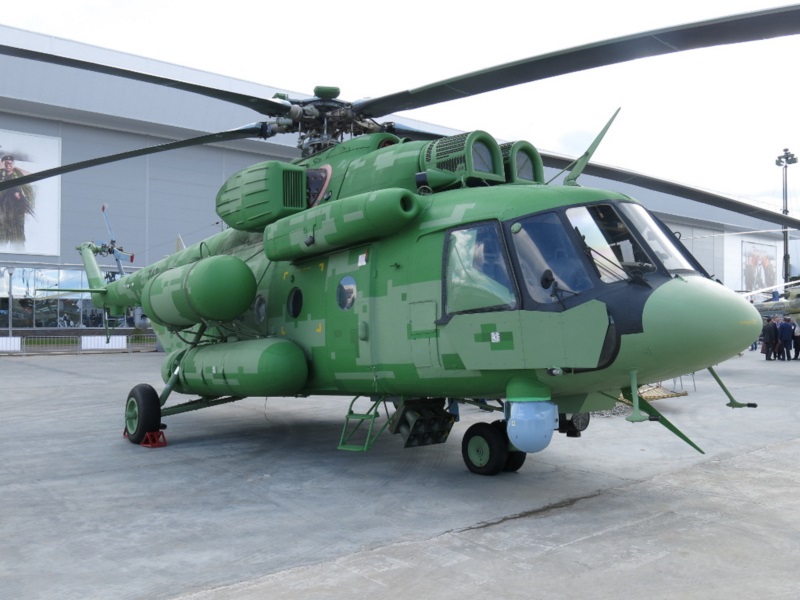
Kazan gave its export machines the "Mi-17" designation, while Ulan-Ude designated its export machines "Mi-171". Variants promoted by Russian Helicopters included:
It is not clear how uniform the configurations of these variants were. Sources also mention specialized variants, such as an electronic warfare platform, but details are scarce. An "Mi-172" has been introduced, being a Hip-3G certified for commercial passenger and VIP service, with square windows and retaining the clamshell doors -- the rear ramp wasn't useful for passenger service. The office of the Russian president obtained one with armor, small square windows, exhaust filters, and chaff-flare dispensers. Kazan also worked on an "Mi-173" with a stretched fuselage and other refinements, but only one was built.
* A redesigned "Mi-38" has been introduced. A prototype with twin Pratt & Whitney Canada (PWC) PW127TS turboshafts was flown in 2003; difficulties over engine issues put the program on hold for several years, but a second prototype flew in 2010, and a third in 2013, with Russian certification following at the end of 2015. Production machines used Russian-built TVA-3000 turboshafts with 1,840 kW (2,465 HP) each.
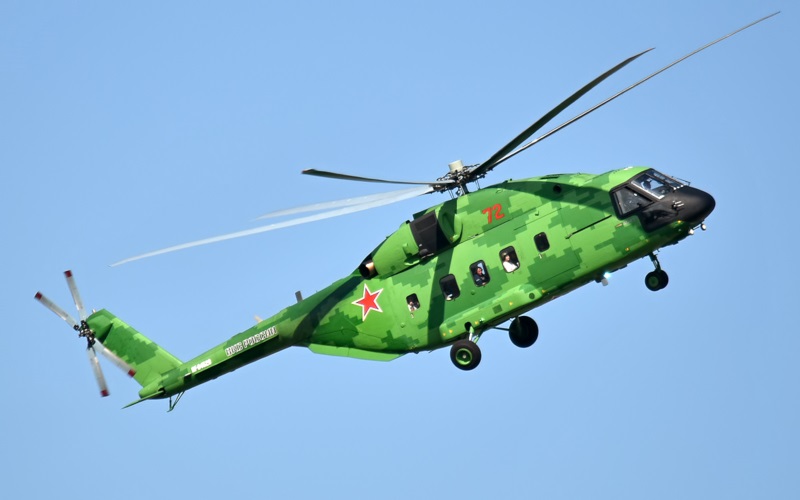
The Mi-38 was externally similar to other late-model Mi-8/17 variants, with a rear loading ramp. It featured extensive composite elements in its airframe, as well as a six-blade rotor and a glass cockpit. A military "Mi-38T" variant, with features such as military avionics, an explosion-resistant fuel system, and auxiliary fuel tanks, first flew in 2018. The Mi-38 has been delivered in small numbers to date.
___________________________________________________________________
MIL MI-38:
___________________________________________________________________
main rotor diameter:
21.1 meters (69 feet 3 inches)
tail rotor diameter:
3.84 meters (12 feet 7 inches)
fuselage length:
19.95 meters (65 feet 5 inches)
height (rotor head):
5.2 meters (17 feet 1 inch)
operating weight:
14,200 kilograms (31,304 pounds)
max loaded weight:
15,600 kilograms (34,390 pounds)
maximum speed:
275 KPH (170 MPH / 150 KT)
service ceiling:
6,500 meters (21,300 feet)
hover ceiling (out of ground effect):
2,500 meters (8,200 feet)
range, no extra fuel:
530 kilometers (330 MI / 290 NMI)
___________________________________________________________________
* Over 17,000 Mi-8 series helicopters have been built, making it one of the most important helicopters ever built, and sales are still going strong. Given the type's sturdiness, there is also a considerable trade in used machines. The fact that purely civil "Hips" are available allows them to be sold over the table to countries under international arms embargoes. Not surprisingly, sometimes the "civil" machines are promptly fitted with combat kit after delivery.
Upgrades are on offer to countries that are users of older Mi-8s. Russian upgrades range from simple refurbishment and "zero-lifing" of airframes -- with new, sturdier composite rotors offered as a somewhat expensive option -- to avionics and weapons upgrades. Kazan Helicopters developed a night combat upgrade for the Mi-MT, with a night vision goggle (NVG) compatible cockpit, a GOES-321 night vision turret, and improved avionics. That particular update was developed in response to a Russian military requirement; updated machines were designated "Mi-8MTKO" or "Mi-17N" for export, and saw combat in Chechnya during the conflicts of the Soviet Succession.
Ukraine, at odds with Russia, implemented its own upgrade program for second-generation Mi-8/17 machines through the Motor Sich company, resulting in the "Mi-8MSB-V", with a zero-lifed and reinforced airframe, TV3-117VM engines, updated avionics, and compatibility with Ukrainian-made weapons. Many of Ukraine's fleet were updated.
Foreign aerospace firms, such as Israel Aircraft Industries (IAI), SAGEM of France, and BAE Systems of the UK, have similarly offered Mi-8 upgrades, though it is difficult to see if there were any takers -- Russian Helicopters having, not surprisingly, done all they could to discourage upgrades by foreign firms.
BACK_TO_TOP